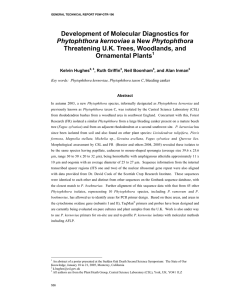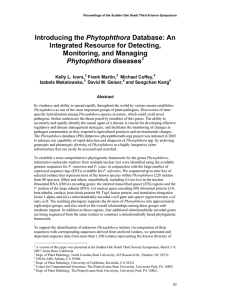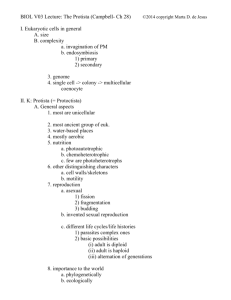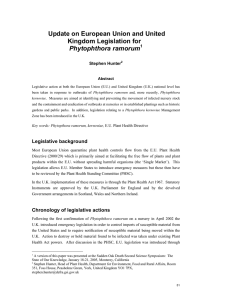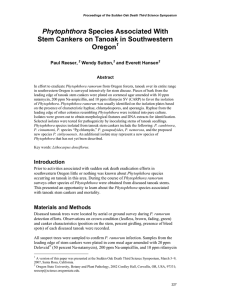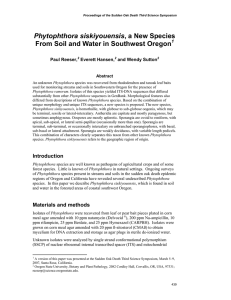Using Single Strand Conformational Phytophthora Species in Oregon Forests Affected by Sudden
advertisement
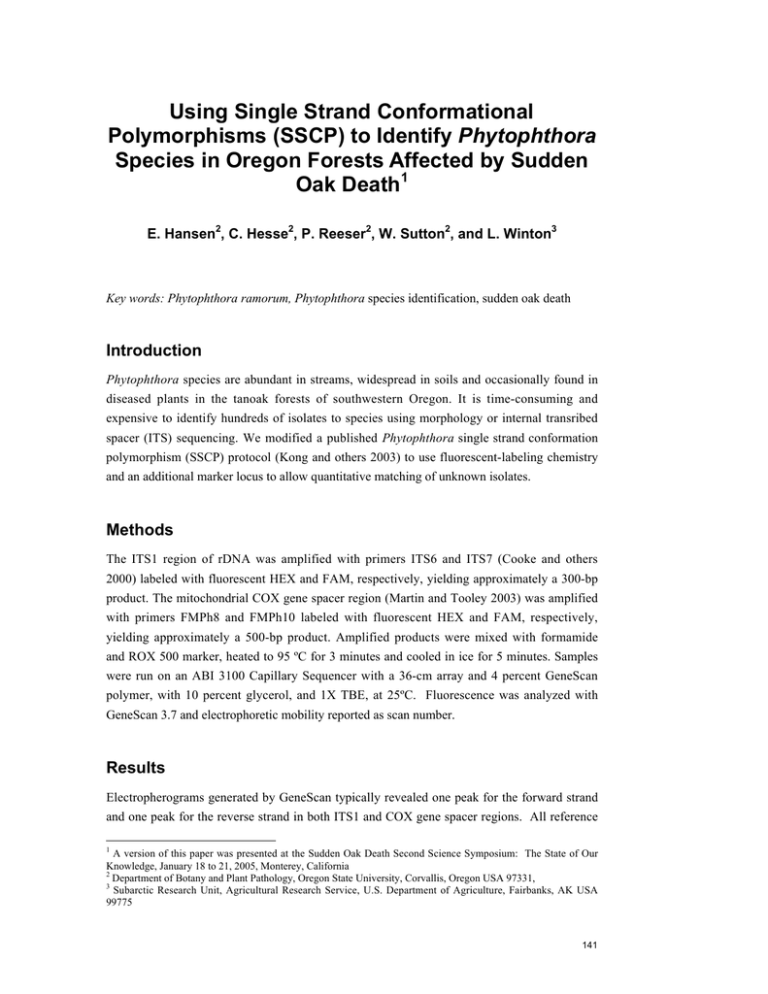
Using Single Strand Conformational Polymorphisms (SSCP) to Identify Phytophthora Species in Oregon Forests Affected by Sudden Oak Death1 E. Hansen2, C. Hesse2, P. Reeser2, W. Sutton2, and L. Winton3 Key words: Phytophthora ramorum, Phytophthora species identification, sudden oak death Introduction Phytophthora species are abundant in streams, widespread in soils and occasionally found in diseased plants in the tanoak forests of southwestern Oregon. It is time-consuming and expensive to identify hundreds of isolates to species using morphology or internal transribed spacer (ITS) sequencing. We modified a published Phytophthora single strand conformation polymorphism (SSCP) protocol (Kong and others 2003) to use fluorescent-labeling chemistry and an additional marker locus to allow quantitative matching of unknown isolates. Methods The ITS1 region of rDNA was amplified with primers ITS6 and ITS7 (Cooke and others 2000) labeled with fluorescent HEX and FAM, respectively, yielding approximately a 300-bp product. The mitochondrial COX gene spacer region (Martin and Tooley 2003) was amplified with primers FMPh8 and FMPh10 labeled with fluorescent HEX and FAM, respectively, yielding approximately a 500-bp product. Amplified products were mixed with formamide and ROX 500 marker, heated to 95 ºC for 3 minutes and cooled in ice for 5 minutes. Samples were run on an ABI 3100 Capillary Sequencer with a 36-cm array and 4 percent GeneScan polymer, with 10 percent glycerol, and 1X TBE, at 25ºC. Fluorescence was analyzed with GeneScan 3.7 and electrophoretic mobility reported as scan number. Results Electropherograms generated by GeneScan typically revealed one peak for the forward strand and one peak for the reverse strand in both ITS1 and COX gene spacer regions. All reference 1 A version of this paper was presented at the Sudden Oak Death Second Science Symposium: The State of Our Knowledge, January 18 to 21, 2005, Monterey, California 2 Department of Botany and Plant Pathology, Oregon State University, Corvallis, Oregon USA 97331, 3 Subarctic Research Unit, Agricultural Research Service, U.S. Department of Agriculture, Fairbanks, AK USA 99775 141 GENERAL TECHNICAL REPORT PSW-GTR-196 isolates were well separated, except when comparing the closely related P. cambivora and P. europaea. Repeat analysis of references showed good repeatability. We drew a blind sample of 54 unknowns from a larger collection of isolates from streams, soil and plants, and ran a preliminary test with 16 reference Phytophthora species, chosen for their perceived relevance to the sampling region. The sixteen references consisted of P. cambivora, P. citricola, P. citrophthora, P. europaea, P. fragariae, P. gonapodyides, P. hibernalis, P . ilicis, P. lateralis, P. megasperma, P. nemorosa, P. pseudosyringae, P. psychrophila, P. ramorum, P. syringae and P. taxon ‘Pg chlamydo.’ SSCP separated the 54 unknowns into 11 distinct groups. Five isolates matched taxon ‘Pg chlamydo,’ six isolates matched P . nemorosa, 22 isolates matched P. gonapodyides, and one isolate matched P. ramorum. The remaining seven unmatched groups suggest a large diversity of Phytophthora species in natural environments. Four isolates from one unique group have been characterized by ITS sequence and culture morphology, and appear to be a new species of Phytophthora. Several of the unknown isolates from stream samples were identified as P. nemorosa, previously known only from tanoak cankers in our area. References Cooke, D.E.L.; Drenth, A.; Duncan, J.M.; Wagels, G.; and Brasier, C.M. 2000. A molecular phylogeny of Phytophthora and related oomycetes. Fungal Genetics and Biology 30: 17-32. Kong, P.; Hong, C.; Richardson, P.A.; and Gallegly, M.E. 2003. Single-strand-conformation polymorphism of ribosomal DNA for rapid species differentiation in genus Phytophthora. Fungal Genetics and Biology 39: 238-249. Martin, F.N. and Tooley, P.W. 2003. Phylogenetic relationships among Phytophthora species inferred from sequence analysis of mitochondrially encoded cytochrome oxidase I and II genes. Mycologia 95: 269-284. 142



